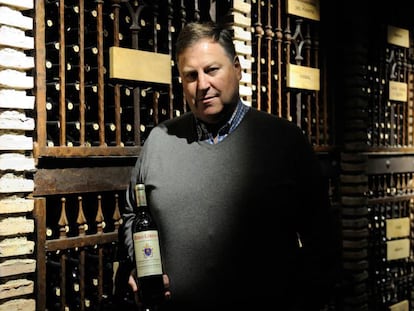Poor grape harvest means less wine in Spain, but of better quality
A tough spring and long, hot summer mean only the best fruit will make it to the bottle

Icy conditions in April, hail, and – above all – drought, have meant wine produced in Spain this year is scarce but excellent. That is the conclusion of Spain’s winemakers weeks out from the start of the 2017 harvest.
All predictions point to a total harvest of 36 million hectoliters against 44 million hectoliters in 2016. This will result in rising prices given the slight uptick in internal demand and strong exports.
Frost in the spring destroyed between 40% and 60% of all wine production in areas with small but high-quality harvests in the north and northeast of Spain. In the Rioja Alta region, losses were estimated at more than 50%.
Prices for La Rioja and Ribera de Duero wines are expected to shoot up after several years of stagnation
Meanwhile, in the Ribera del Duero region, which produces more than 120 million kilograms of grapes, that figure is thought to be around 30%, according to José Manuel Pérez Ovejas, wine expert with Viña Pedrosa cellars. But Pérez Ovejas says there is a silver lining: the grapes that have survived are set to produce an excellent wine.
In the Castilla-La Mancha region, production will be down from 24 million tons to 22 million tons, industry groups believe. But this is not just because of the drought and the hail that battered the region in June. The regional government also decided to cut the permitted grape yield per kilometer from 40,000 kilograms to 30,000 kilograms.
The regional agricultural minister, Francisco Martinez Arroyo, justified this decision saying the region was opting for quality over quantity and to ensure that winemakers were getting their money’s worth when buying grapes from growers. The ministry is also restructuring the industry with the aim of getting wine growers to choose high-quality grape varieties over high-yield types.
Poor weather conditions have affected grape growers across Europe, especially Spain’s chief competitors in Italy and France. Overall wine production in the European Union is expected to be 10% lower this year for a total of 148 million hectoliters.
As a result, producers are convinced that prices of wines from quality-controlled Denomination of Origin areas including La Rioja or Ribera de Duero will shoot up after several years of stagnation. Grape prices are forecast to be €2 per kilogram against €1 last year. In areas of mass production such as Castilla-La Mancha, prices are set to at least match those of 2016.
The poor harvests expected in other European countries are also expected to drive up exports of Spanish wine. France has brought up to five million hectoliters of Spanish wine, most of that of lower quality. However, the average price of those exports is up 6.5% to €1.20 a liter.
English version by George Mills.
Tu suscripción se está usando en otro dispositivo
¿Quieres añadir otro usuario a tu suscripción?
Si continúas leyendo en este dispositivo, no se podrá leer en el otro.
FlechaTu suscripción se está usando en otro dispositivo y solo puedes acceder a EL PAÍS desde un dispositivo a la vez.
Si quieres compartir tu cuenta, cambia tu suscripción a la modalidad Premium, así podrás añadir otro usuario. Cada uno accederá con su propia cuenta de email, lo que os permitirá personalizar vuestra experiencia en EL PAÍS.
¿Tienes una suscripción de empresa? Accede aquí para contratar más cuentas.
En el caso de no saber quién está usando tu cuenta, te recomendamos cambiar tu contraseña aquí.
Si decides continuar compartiendo tu cuenta, este mensaje se mostrará en tu dispositivo y en el de la otra persona que está usando tu cuenta de forma indefinida, afectando a tu experiencia de lectura. Puedes consultar aquí los términos y condiciones de la suscripción digital.
More information
Archived In
Últimas noticias
Most viewed
- Reinhard Genzel, Nobel laureate in physics: ‘One-minute videos will never give you the truth’
- Oona Chaplin: ‘I told James Cameron that I was living in a treehouse and starting a permaculture project with a friend’
- Pablo Escobar’s hippos: A serious environmental problem, 40 years on
- Why we lost the habit of sleeping in two segments and how that changed our sense of time
- Chevy Chase, the beloved comedian who was a monster off camera: ‘Not everyone hated him, just the people who’ve worked with him’










































